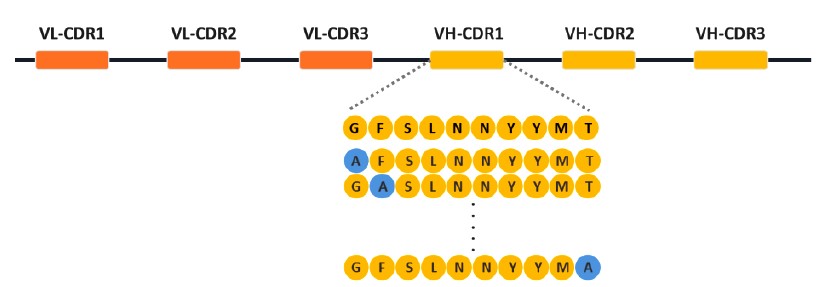Alanine Scanning Mutagenesis: A Versatile Approach to Map Proteins' "Hot Spots"
Site-directed mutagenesis strategies are essential for elucidating protein structure-function relationships and understanding protein-protein interactions. Among different approaches, alanine scanning mutagenesis is a versatile strategy that allows researchers to evaluate the role and relevance of specific amino acid sidechains within protein regions of interest (Weiss et al. 2000).
In conventional alanine scanning mutagenesis, single non-alanine residues are methodically substituted by alanine, generating mutant libraries for functional testing. Alanine scanning mutagenesis libraries have been instrumental for dissecting critical residues or "hot spots" for protein-protein interactions. For example, this approach supported identifying residues essential to the interaction between human growth hormone (hGH) and its receptor (Cunningham and Wells 1989). Additionally, an alanine scanning mutagenesis strategy allowed mapping residues in human Fas ligand (L)/CD95L necessary for Fas receptor interaction and critical for inducing cytotoxic activity (Nisihara et al. 2001).
During the ongoing COVID-19 pandemic, investigators have harnessed the versatility of alanine scanning mutagenesis to map "hot spots" in SARS-CoV-2. For example, most recently, Suryadevara et al. 2021 leveraged alanine scanning to map new neutralizing epitopes in the Spike protein. Most SARS-CoV-2 neutralizing antibodies identified to date bind to the Spike's protein RBD. However, Suryadevara et al. isolated human-derived neutralizing monoclonal antibodies targeting the Spike N-terminal domain. By generating an alanine scanning mutagenesis library of Spike's N-terminal domain, Suryadevara and colleagues identified specific amino acids necessary for antibody binding. These N-terminal domain Spike epitopes may provide new alternatives for immunogen design and therapeutic development.
Alanine scanning mutagenesis has also enabled mapping antibody paratopes important for binding to the SARS-CoV-2 Spike protein. Recently, scientists at GenScript leveraged this approach to identify "hot spots" within the CDRs of a SARS-CoV2 antibody (BS-R2B12). The SARS-CoV-2 monoclonal antibody BS-R2B12 binds with high affinity (~10-10 M) to the Spike protein's RBD and is just one of the many COVID-19 reagents developed by GenScript's scientists during the pandemic.
Identification of "Hot Spots" in the CDRs of a SARS-CoV-2 Antibody by Alanine Scanning

High-throughput site-directed mutagenesis allowed the generation of an alanine scanning mutant library for a previously developed antibody to SARS-CoV-2 (BS-R2B12). A total of 66 mutants were generated where single non-alanine residues within the complementarity determining regions (CDR) of BS-R2B12 were replaced with alanine. Read Application Note »
Alanine scanning mutagenesis across all six CDRs in BS-R2B12 generated a total of 66 mutants for functional evaluation, leading to the identification of 13 residues critical for antibody binding to RBD. These identified "hot spots" could be further targeted to enhance antibody binding to Spike's RBD.
Overall, alanine scanning mutagenesis is a powerful tool that facilitates identifying protein residues of functional relevance. For the development of therapeutics, such as vaccines or antibody-drugs, alanine scanning mutagenesis may serve as an efficient tool to inform immunogen design. Lastly, in protein engineering workflows, alanine scanning may help pinpoint residues that could be further modified to improve desirable protein properties.
Reference
Cunningham, B. C. & Wells, J. A. High-resolution epitope mapping of hGH-receptor interactions by alanine-scanning mutagenesis. Science (80-. ). (1989) doi:10.1126/science.2471267.
Nisihara, T. et al. Humanization and Epitope Mapping of Neutralizing Anti-Human Fas Ligand Monoclonal Antibodies: Structural Insights into Fas/Fas Ligand Interaction. J. Immunol. (2001) doi:10.4049/jimmunol.167.6.3266.
Suryadevara, N. et al. Neutralizing and protective human monoclonal antibodies recognizing the N-terminal domain of the SARS-CoV-2 spike protein. Cell (2021) doi:10.1016/j.cell.2021.03.029.
Weiss, G. A., Watanabe, C. K., Zhong, A., Goddard, A. & Sidhu, S. S. Rapid mapping of protein functional epitopes by combinatorial alanine scanning. Proc. Natl. Acad. Sci. U. S. A. (2000) doi:10.1073/pnas.160252097.
- Like (4)
- Reply
-
Share
About Us · User Accounts and Benefits · Privacy Policy · Management Center · FAQs
© 2026 MolecularCloud



